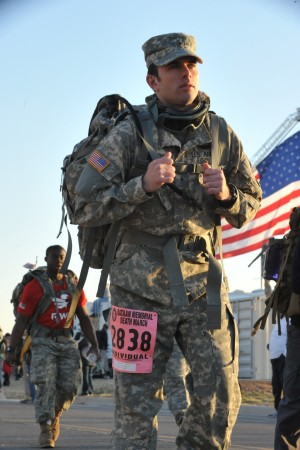Army Guard Aviator Proves Himself During New Mexico
| DMNA Home page | More News Stories |
Story by: Eric Durr - Division of Military and Naval Affairs
Dated: Tue, Apr 15, 2014
WHITE SANDS, New Mexico-- At mile three the blisters started.
So New York Army National Guard Warrant Officer John Seeger decided he was not going to take his boots off until he finished the entire 26.2 mile route of the Bataan Memorial Death March.
If he did that, he realized, they would never go back on again. “I just toughed it out for the next 23 miles,” Seeger said. “I just put my head down and went.”
Seeger, a UH-60 pilot assigned to the 3rd Battalion 142nd Aviation, and a technician at the Army flight facility in Ronkonkoma, was one of more than 6000 military members and civilians who took part in the March 23 event. The march commemorates Americans who suffered at the hands of the Japanese during World War II.
“It was one of those things you want to do,” the 36-year old Seeger explained.
The Bataan Memorial March began in 1989 when the Army ROTC Department sponsored the event to commemorate the Soldiers who surrendered to the Japanese in April 1942 during the invasion of the Philippines, then an American possession.
The 60,000 Americans and Filipinos that surrendered on the Bataan Peninsula were marched 80 miles to prisoner of war camps. The Soldiers were not fed,denied water and hundreds were beaten and shot out of hand. 1, 800 New Mexico Army National Guard Soldiers were among those captured.
In 1992 the march moved to White Sands Missile Range. The route goes from flat desert to high mountains.
Seeger found out about the annual event three years ago. But his job, and his family--”two boys and two girls--”made it hard to find the time.
When he decided he would be able march this year --”the 25th anniversary march--”he was a little more than a month and a half out from the march weekend.
The Death March website suggests taking six months to get ready to participate; working up to 15 mile marches to toughen up the feet.
But it was the middle of a snowy, nasty Center Moriches, Long Island New York winter. And there aren’t a lot of mountains to train on there.
He spent a month walking on a treadmill daily with his rucksack instead.
He entered in the “heavy military” march category. That means carrying 35 pounds from start to finish. Most marchers carry food which is donated to a food pantry.
The march website warns about hazards ranging from tough rocky ground and sun that can cause a burn in 15 minutes, to snakes and scorpions and unexploded ordnance.
March day started warm and got hot, Seeger recalled. The opening ceremony, ”which included appearances by Bataan Death March survivors, started at 6:45 a.m. He started walking at 7:45 a.m.
The first two miles were on pavement. Then the road ended and it was loose sand, clay and rocks for four or five miles. Then after mile eight he hit the mountains for another four miles, going from about 4,300 feet above sea level to 5,400 feet. And then it was back down.
Every two miles there was a water point, and he sipped continually from a water bladder, Seeger said.
At mile ten, his cell phone died. No chance of talking to his wife Rebekah back in Long Island.
The 6,000 marchers separated into loners, like himself, or small groups, Seeger said. At one point towards the end of the march he hit an incline, and then a long stretch that was essentially a sand pit.
“I remember thinking to myself, ‘My God. When is this going to be over.’ And I remember thinking ‘ I know when it is going to be over but the original guys on Bataan who went through this did not,’” he said.
“That was what kept me going,” he added. When he finally reached the 26. 2 mile mark the first thing he did was take off his pack.
“Just taking that pack off, and giving it to the guy (at the finish line) was just such a feeling that: ‘Thank God’ I can take that thing off for good,” he recalled.
“You are pretty much overcome with emotion. It was such a huge milestone just being in that race,” he added. The next thing he did was call his wife.
“She was happy I was alive,” he said. “I had not spoken to her since the beginning of the race.”
His feet hurt, his legs hurt, and he was beat after 11 hours and 18 minutes on the trail. But Seeger is already planning a repeat performance.
“I will definitely be back there again next year. Just the people you meet and the significance of what it means makes it worthwhile,” he explained.
URL: https://dmna.ny.gov/news/?id=1397587119
216.73.216.158
Page Last Modified: Tue, Apr 15, 2014




